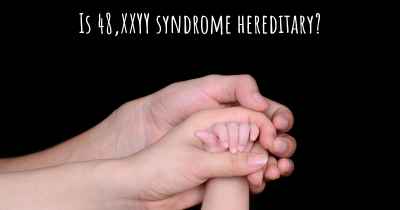What is the history of 48,XXYY syndrome?
When was 48,XXYY syndrome discovered? What is the story of this discovery? Was it coincidence or not?

48,XXYY syndrome is a rare genetic disorder that affects males. It is characterized by the presence of an extra X and Y chromosome, resulting in a total of 48 chromosomes instead of the typical 46. This condition was first described in medical literature in the late 1960s, and since then, significant progress has been made in understanding its causes, symptoms, and management.
The history of 48,XXYY syndrome begins with the discovery of chromosomal abnormalities in individuals with intellectual disabilities. In the mid-20th century, advancements in cytogenetics allowed scientists to identify and study chromosomal variations associated with various genetic disorders. It was during this time that researchers started noticing individuals with an extra X and Y chromosome, leading to the identification of 48,XXYY syndrome.
The first documented case of 48,XXYY syndrome was reported in 1960 by Dr. Patricia Jacobs and her colleagues. They described a 15-year-old boy with tall stature, learning difficulties, and delayed puberty. Chromosome analysis revealed the presence of an extra X and Y chromosome, which was a novel finding at the time. This groundbreaking discovery laid the foundation for further research into this rare genetic condition.
Over the next few decades, more cases of 48,XXYY syndrome were identified, and researchers began to observe common characteristics and symptoms associated with the condition. These include developmental delays, learning disabilities, speech and language difficulties, behavioral problems, tall stature, and hormonal imbalances. The variability in symptoms and the wide range of severity made it challenging to establish a definitive clinical picture of the syndrome.
Advancements in genetic testing in the 1990s and early 2000s greatly contributed to the understanding of 48,XXYY syndrome. The development of fluorescence in situ hybridization (FISH) and other molecular techniques allowed for more accurate and efficient detection of chromosomal abnormalities. This led to an increase in diagnosed cases and a better understanding of the prevalence and genetic mechanisms underlying the syndrome.
As research progressed, scientists discovered that 48,XXYY syndrome is typically not inherited from parents but rather occurs as a result of random errors during sperm or egg formation. The extra X and Y chromosomes usually arise from nondisjunction, a process where chromosomes fail to separate properly during cell division. This leads to an abnormal number of chromosomes in the resulting sperm or egg, which can then combine with a normal gamete to form an embryo with 48 chromosomes.
With a better understanding of the genetic basis of 48,XXYY syndrome, researchers have been able to explore potential treatments and interventions. Early diagnosis and appropriate management can significantly improve the quality of life for individuals with this condition. Multidisciplinary approaches involving medical professionals, psychologists, speech therapists, and educators have been developed to address the specific needs of individuals with 48,XXYY syndrome.
Today, support groups and advocacy organizations play a crucial role in raising awareness about 48,XXYY syndrome and providing resources for affected individuals and their families. Ongoing research continues to expand our knowledge of the syndrome, including its long-term outcomes, potential comorbidities, and optimal treatment strategies.
In conclusion, the history of 48,XXYY syndrome spans several decades of scientific discovery and medical advancements. From its initial description in the 1960s to the present day, researchers have made significant progress in understanding the causes, symptoms, and management of this rare genetic disorder. The development of genetic testing techniques and multidisciplinary approaches has improved the lives of individuals with 48,XXYY syndrome, and ongoing research continues to expand our knowledge and improve outcomes for affected individuals.








